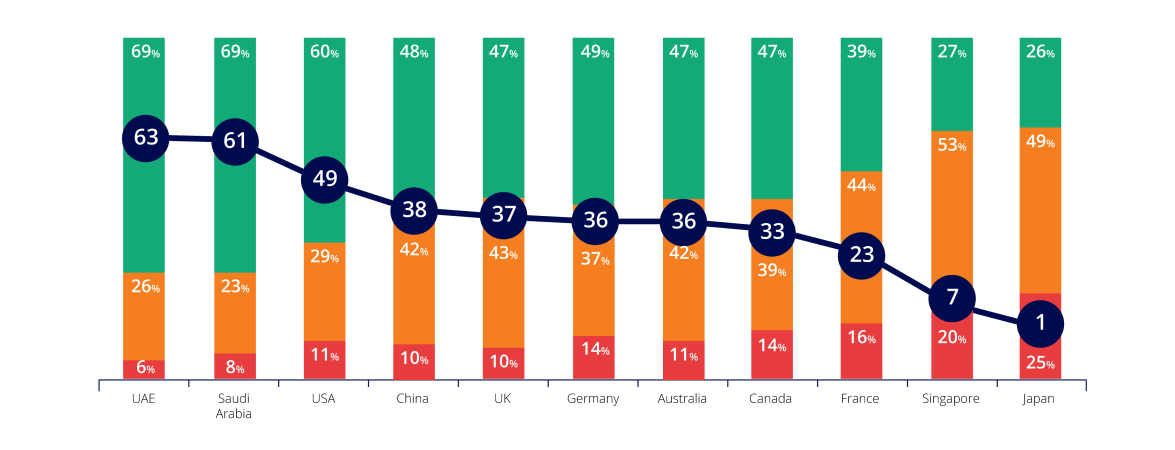What Is a Net Promoter Score and Why It Matters

Behind every thriving business is a loyal customer base. It all starts with customer satisfaction, but loyalty goes a step further. Loyal customers return, spend more, and bring others with them. Net Promoter Score (NPS) helps you measure and grow that loyalty.
NPS is a measure that informs you how individuals feel about your business and what you should do differently to develop. Are you launching a new product, marketing initiative, or attempting to reduce churn? NPS gives you a clear signal from your customers.
This guide is written for marketers, data analysts, and market researchers who want to learn what NPS is, how to calculate it, how to know a good score is, and how to design NPS surveys. You'll learn how to make the best decisions using NPS data and improve customer experience.
By the end, you'll have a solid understanding of the NPS Net Promoter Score definition and how to run a successful NPS program.
What is a Net Promoter Score?
NPS is a simple measure of how likely your customers are to recommend your company, product, or service to other consumers. It's based on one clear question:
"On a scale from 0 to 10, how probable would you be to recommend [your company/product/service] to a colleague or friend?"
Customers provide a score, and based on their answer, they are placed in one of three groups:
- Promoters (score 9–10): They are your loyal supporters. They are fond of your company and will probably recommend you to someone else.
- Passives (score 7–8): They're okay with your products or services, but not excited about them. Passives don't harm your brand, but they won't help you promote it either.
- Detractors (score 0–6): Unhappy customers. They can share their unhappiness with others and harm your reputation.
The NPS question is a snapshot of customer opinion overall.

While it is just one question, NPS offers a wealth of insight when paired with follow-up questions and additional analysis (of which we'll have more to say later in this guide).
How to calculate Net Promoter Score
Once you've collected answers to your NPS surveys, the score is easy to calculate. Here is the formula:
NPS = % of Promoters – % of Detractors
Let's go through the steps to see how the score is calculated in detail.
Step 1: Classify the responses
You divide the responses into three groups based on their scores:
- Promoters who answered 9 or 10
- Passives who answered 7 or 8
- Detractors who answered 0 to 6
Keep in mind that only promoters and detractors are used in the final Net Promoter Score calculation.
Step 2: Calculate the percentages
Wondering how you calculate Net Promoter Score? Find the percentage of promoters and detractors:
- % Promoters = (Number of Promoters ÷ Total Responses) × 100
- % Detractors = (Number of Detractors ÷ Total Responses) × 100
Example: Let's say you had 100 survey responses.
- 60 gave a 9 or 10 → 60% Promoters
- 20 gave a 7 or 8 → 20% Passives
- 20 gave 0 to 6 → 20% Detractors
Step 3: Apply the formula
Now subtract the percentage of detractors from the percentage of promoters:
NPS = 60% – 20% = +40
That's your Net Promoter Score, which is +40.
Why is it calculated this way?
The Net Promoter Score formula focuses on the net difference between people who love your brand (promoters) and those who could damage your brand (detractors). Passives are excluded, filtering out neutral opinions and focusing on the customers who are most vocal.
This makes NPS:
- Easy to understand and explain
- Useful for tracking any changes over time
- A powerful tool for comparison between products, teams, or even competitors
What is a good Net Promoter Score?
The best score depends on several things, like your industry, location, and customer expectations. But there are some general rules and benchmarks to guide you.
Understanding NPS score ranges
NPS scores can range from –100 to +100:
A rating higher than 0 is actually a good start. It indicates more people like you than dislike you. But most companies need +50 or higher to be competitive.
Industry benchmarks (2024–2025)
NPS benchmarks differ a bit depending on your industry. Here's a quick overview based on recent data:
Don't compare your NPS to those of other Net Promoter Score companies in completely different industries. A +30 in telecom might be great, while the same +30 in SaaS might be mediocre.
For a clearer perspective, look at a relevant Net Promoter Score example within your own field.
Regional differences
Expectations also vary by country. For example, in some countries, people would give "middle" scores (7–8), lowering overall NPS. In other places, customers might be more enthusiastic with 9s and 10s.

As highlighted in B2B International's research:
"The number of passives (7–8 scorers) were significantly higher in Japan and Singapore […] while simultaneously having a significantly higher number of detractors. […] Asian countries studied […] gravitate towards passive / more middle-range scores as opposed to extreme positive scores (9/10)."
So if you're working with cross-border teams or work for global consumers, keep an eye on cultural rating behaviors.
What is the most valuable benchmark? Your own past performance.
Track your NPS over time to see if your efforts are taking hold. Use it to find trends, try out new ideas, and boast of success.
12 Net Promoter Score questions and examples
To get useful data from an NPS survey, you have to start with the correct questions. In this section, you'll see examples, including the main NPS question and follow-up questions. With them, you'll get more detailed information from your customers.
The сore NPS question (always include)
At the heart of every NPS survey is this fundamental Net Promoter Score question: "On a scale of 0 to 10, how likely are you to recommend [Company/Product/Service] to a friend or colleague?"
- 0 = Not at all likely
- 10 = Extremely likely
This question gives you the information to calculate your Net Promoter Score. But it doesn't have to be one-size-fits-all. Make the question your own:
- "How likely are you to recommend [Our Product] to someone in your industry?
- "How likely are you to recommend [Our Support Team] after your recent experience?"
- "Based on your last purchase, how likely are you to recommend us?"
Adjusting the question helps you target precise areas of the customer experience – product experience, customer support, onboarding, and more.
Optional but powerful follow-up questions
The score does not indicate why customers perceive your brand/product/service as they do. To find out why, include 1–2 open-ended Net Promoter Score survey questions following the main one. Here are a few examples of useful follow-up questions:
To all customers
- "What's the reason for your score?"
- "What would make your experience better?"
To promoters (9–10)
- "What was your favorite part of your experience?"
- "Would you be happy to provide a review or testimonial?"
To passives (7–8)
- "What kept you from giving us a better score?"
- "How can we make your experience go from good to great?"
To detractors (0–6)
- "What went wrong or didn't meet your expectations?"
- "How can we fix or improve this for you?"
Make NPS surveys easy with Checkbox. Contact us to get full details and support!
How to write great Net Promoter Score surveys
Creating a good Net Promoter Score survey is about more than just choosing the right questions. It's also about when, how, and how often you ask them.
NPS survey best practices
Is your goal to get honest, useful feedback without overwhelming your customers? Then, follow these best practices.
Make surveys short and simple
NPS surveys work best when they're short and easy to respond to. Limit it to the bare-bones question and 1–2 max follow-ups.
Here are a few Net Promoter Score question examples:
- Q1: How likely are you to recommend us? 0–10
- Q2: What was your main reason for your score?
Use clear and friendly language
Avoid using jargon or overly technical language. Speak in a friendly and conversational way.
Instead of: "Rate your likelihood to recommend our service based on your last interaction," try natural voice of the customer questions. For example: "How likely would you be to recommend us to a friend?", "Would you tell a friend about us?".
Personalize where possible
Refer to the product, service, or experience you want feedback on. Personalization makes the survey more relevant.
Example: "How likely are you to recommend us following your recent purchase of [Product Name]?"
Ask at the right time
Send the survey soon after a key interaction, meaning after a purchase, customer support call, or onboarding. This way, the experience is fresh in mind.
Make it easy to respond
Use a simple Net Promoter Score scale (0–10) and mobile-friendly formats. The less complicated, the higher your reply rates.
How often should you run NPS surveys?
Businesses usually run NPS surveys quarterly or biannually to keep track of trends without overwhelming customers.
What's important to know about event-driven customer surveys? Send them immediately after purchase, support interaction, or product launch to get instantaneous feedback.
How to analyze Net Promoter Score data
Once you've collected your NPS survey responses and calculated your score, the real work begins: making sense of it all and deciding what to do with it. This is where the value of understanding NPS truly comes in. Think of it as your Net Promoter Score explained in action, helping you turn survey data into strategy.
1. Look beyond the number
Your NPS score gives you an at-a-glance snapshot of customer loyalty, but it doesn't tell you everything. How do you research Net Promoter Score effectively? To get the full picture, you need to go deeper. To get the true insights:
Review the distribution of scores
See how many passives, promoters, and detractors you have. Having a high number of passives (7–8) may mean customers are satisfied but not excited.
Read the comments
Qualitative feedback from follow-up questions is gold. Look for common themes or repeated issues. This helps you understand why your customers feel the way they do.
2. Segment your data
Split your NPS data by different groups to find trends or problem areas:
- By customer type (new vs. existing customers)
- By product or service line
- By geography or country
- By channel (online, in-store, support calls)
Segmenting helps you understand which groups need more attention and which are your biggest fans.
3. Track NPS over time
NPS is a trend metric, so measuring it on a regular basis helps you understand if changes you make increase customer loyalty. Tips to consider:
- Plot your NPS scores on a timeline (weekly, monthly, quarterly)
- Look for spikes (positive or negative) and match them to particular changes or events you introduced
4. Set benchmarks and targets
Use industry Net Promoter Score benchmarks or your own historical data to set realistic targets for improvement.
5. Share insights with your team
NPS data is valuable to many parts of your business:
- Marketing can use it to target messaging
- Customer support can identify and address pain points
- Product teams can prioritize new features or improve existing ones
- Leadership can track overall customer health
6. Plan your next steps
Data won't improve your business, but action will. Use insights from NPS analysis to fix issues raised by detractors, reward and praise promoters, and turn passives into promoters with focused effort.
How to improve your Net Promoter Score
Calculating Net Promoter Score NPS is just the start. The value is in using that knowledge to make smart decisions and improve your customer experience, and ultimately, your business.
Identify key issues from feedback
Listen to what your detractors and passives are saying. Are there any consistent complaints or issues? These might be:
- Slow customer service
- Product quality issues
- Confusing checkout process
- Poor communication
Fixing these pain points must be a top priority.
Activate your promoters
Your promoters are your biggest fans. They can help you spread positive word of mouth, write testimonials or reviews, and participate in case studies or referrals. Encourage and reward their loyalty with special offers or recognition.
Close the loop
Reach out to unhappy customers to understand their problems and offer solutions. Let customers know you've listened and are working on improvements. Share positive customer feedback with your teams to boost morale.
Closing the loop builds trust and shows that you care about customers.
Align your teams
NPS impacts numerous departments, so share results with:
- Customer service teams to improve support
- Marketing teams to develop messaging and campaigns
- Product teams to prioritize features or fixes
- Leadership to guide overall strategy
Make NPS a company-wide priority, not just a marketing metric.
Final thoughts
Net Promoter Score is a popular and powerful method of measuring the level of happiness of your customers and their loyalty. It informs you of what you are doing well and what you have to change.
In this guide, we showed you what NPS is, how to calculate the numbers, and how to ask the correct questions to run an effective Net Promoter Score program. We also walked you through how to interpret the data and how to act on it.
The most important thing is to listen to your customers and take action on their feedback. Share the results with your team, and join forces to make your product or service better.
Start using NPS today and you'll build stronger relationships with your customers and help your company grow. To make it easier to create effective surveys, you can use Checkbox.
This Net Promoter Score tool with features to help you set up a Net Promoter Score calculator, lets you create effective NPS surveys and deploy them across multiple environments, including cloud, on-premises, and white-label hosting. Request a demo today!
Net Promoter Score FAQs

Understanding this article's Net Promoter Score definition is essential for any business to improve customer experience. NPS helps businesses calculate customer satisfaction and loyalty to forecast growth and determine areas of improvement.

This score measures how likely employees are to recommend their workplace. Helps companies to decide about employee satisfaction and engagement.

A good employee Net Promoter Score starts above 0, with top companies aiming for +50 or more, based on industry employee Net Promoter Score benchmark.

No, NPS Net Promoter Score is not a percentage. It's a -100 to +100 score based on the percentage of promoters minus the percentage of detractors.


